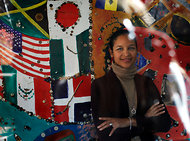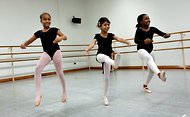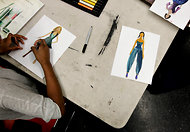At Harlem Arts School, New Chief Hits Her Stride
An ordinary Saturday at the Harlem School of the Arts finds children in black tights learning dance moves, pecking away at keyboards or torturing clay into intricate shapes. Given its recent travails, ordinary is most desirable here.

In April of 2010, financial problems led to a three-week shutdown. Even now, the community arts school, which for more than 35 years has helped tens of thousands of children receive arts training, faces a debt of $2 million with no endowment, a fraction of its former attendance and only 2 of its 32 pianos in good condition. But thanks to the efforts of a new chief executive and a constellation of other supporters, the Harlem School of the Arts does have one thing that has long been in short supply: optimism.
Yvette L. Campbell, in her first year (she started in January) as president and chief executive, has cajoled $2 million from donors both old and new, trimmed the operating budget by 30 percent and won the support of other arts and academic organizations.

“We’re doing what we said we were going to do,” said Ms. Campbell, 45, who was a dancer with the Alvin Ailey Repertory Ensemble and Elisa Monte Dance and the former administrator of the Ailey extension program. “It’s been quality arts. I see the possibilities and I am trying to get believers on my train.”
Her believers include Geoffrey Canada, the president and chief economic officer of the Harlem Children’s Zone. He has started sending hundreds of children from his education and social service program to the school at 645 St. Nicholas Avenue (at 141st Street) for classes in the school’s four divisions: dance, music, theater and visual arts.
And Lincoln Center is considering a partnership with the school. Reynold Levy, the president of Lincoln Center and a member of the school’s advisory council, called Ms. Campbell “a force of nature” who has built relationships and trust with people now committed to seeing the school survive. “By the time she walks out of your office, you’re sold,” he said.
Saving the nonprofit school is a major concern, particularly in Harlem. Founded in 1964 when the concert soprano Dorothy Maynor gave piano lessons at a nearby church, the Harlem School of the Arts has its roots in the struggles of the 1960s, when many black children did not have easy access to arts training.

Since then it’s expanded to include community and summer programs and some that it runs in public schools. The children’s program charges tuition for group and private lessons for students 2 through 18. The cost for a semester (17 weeks) of classes is generally under $1,000. The courses are wide-ranging: piano, voice, percussion, tap, ballet, hip-hop, playwriting, acting, drawing, photography and graphic design, among others.
The prep program is a selective pre-professional, scholarship course of study for students 12 through 18. Though not a full-fledged school offering arts and academics, like LaGuardia, the performing arts high school, it provides advanced training in all four arts divisions, and its students (including Giancarlo Esposito) have gone on to conservatories like Juilliard, as well as to Broadway and feature films.
“We will not allow this institution to fail; it’s far too important,” said Charles J. Hamilton Jr., a senior counsel at the law firm Windels Marx Lane & Mittendorf, who became the chairman of the school’s board in 2010. “This school saves lives, period. It produces extraordinary young people who go off in life with an appreciation for life and an appreciation of themselves. There aren’t a lot of other institutions in our community that do that.”
The school is increasingly important as financial support for arts education has been whittled away in the public schools, some education and arts leaders say. School funds for art supplies, musical instruments and equipment declined by almost 80 percent from the 2006-7 school year to the 2009-10 school year, according to a report by the Center for Arts Education, which works to expand arts education opportunities for New York public school students.
The choice between academics and arts education is a false one, Mr. Canada said.
“To think that poor children are going to have a full education experience without this exposure is a mistake,” he said. “We’re thinking about the time that children are not in school, and just watching TV or playing video games is not an option.”
The news that the school had run out of money hit Harlem hard, especially since few had any idea it was in such bad shape.
A report in The New York Times in 2010 showed that by 2004, the school was in trouble and losing donors. Its $2 million surplus had turned into a deficit; nearly half a million in payroll taxes had gone unpaid; and a $1.5 million grant and the proceeds from a $1 million loan could not be accounted for.
The school was able to reopen because of a $1 million gift from four donors and the assistance of Mayor Michael R. Bloomberg and other city officials, who helped picked the board that hired Ms. Campbell.
“What we found simply was a diamond,” Mr. Hamilton said of Ms. Campbell, a mother of two with a bachelor’s degree in both applied mathematics and dramatic art-dance. “She has this energy, this spirit, this motion. She connects with parents and with students. And she’s not afraid of a spreadsheet.”
The school just feels better, said Susan Lee, who has spent 12 years taking her 16-year-old daughter, Nicole Hines, to the school, first for “Mommy and Me” programs and now for dance lessons. Since Ms. Campbell arrived, board members come to events, and parents are welcome at board meetings; administrators are approachable; and teachers no longer complain about not being paid, she said.
This semester the school is serving more than 2,400 students citywide, including 500 in the building. (Some programs are held outside the main headquarters.) At its peak in the early ’90s, the school served 3,000 students citywide.
For the first time in many years, the school is offering financial aid to students, and has its first early-childhood classes for ages 2 through 4. Ms. Campbell, whose paternal grandfather was Lincoln Perry, the actor known as Stepin Fetchit, has hired high-profile teachers, like Maria Ahn to teach cello. Aubrey Lynch II, a former Ailey dancer and a choreographer and producer who appeared in the original cast of “The Lion King,” now presides over the dance division and a new musical theater program.
To increase visibility, Ms. Campbell and her students have spent the last year getting around. In September the visual arts students appeared on an episode of the Lifetime TV show “Project Runway,” which features fashion design competitions. And last month dance students performed at the Apollo Theater during the Bessie Awards, while theater students performed a dramatic piece at the Jewish Museum during a day to celebrate the work of the author and illustrator Ezra Jack Keats.
“These are tough times, but tough times are when you need the arts,” Ms. Campbell said. “The Harlem Renaissance, blues, jazz, hip-hop — they all came out of hard times and the possibility of change.”